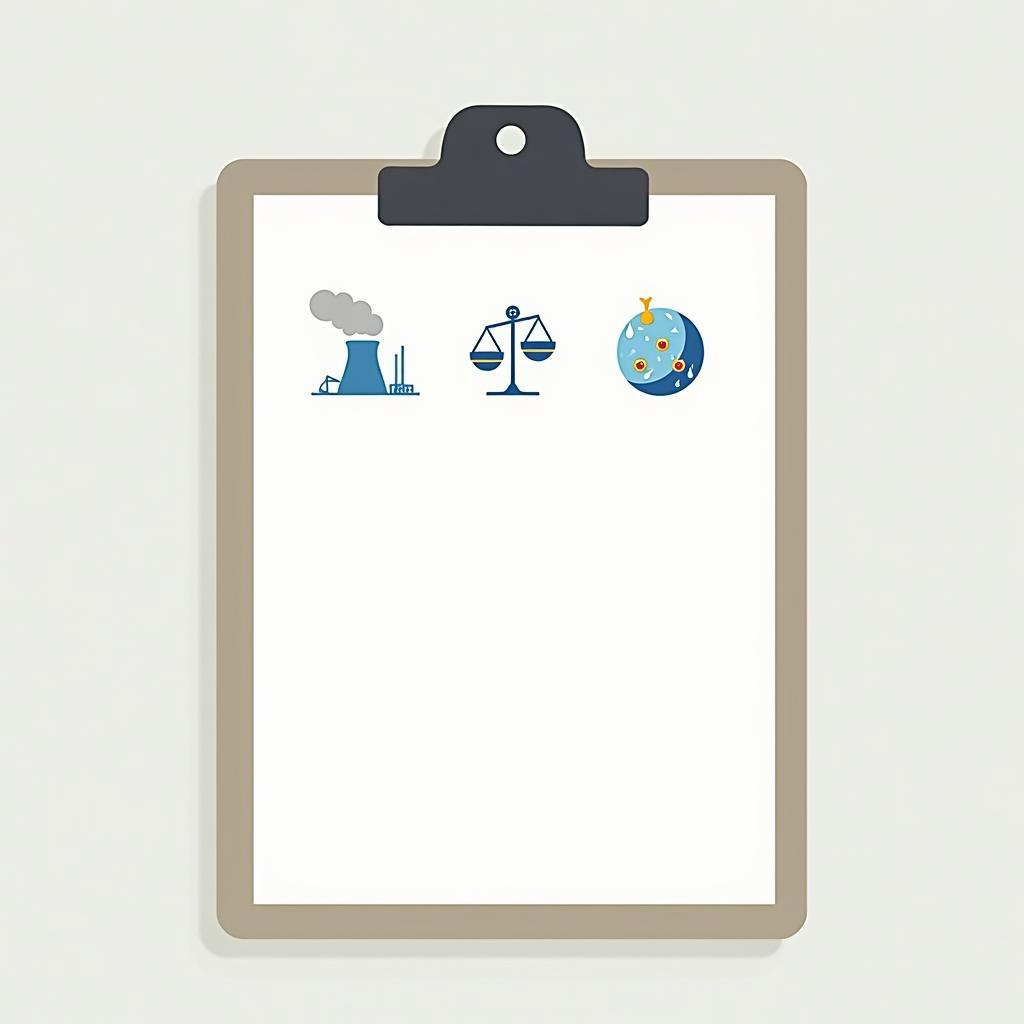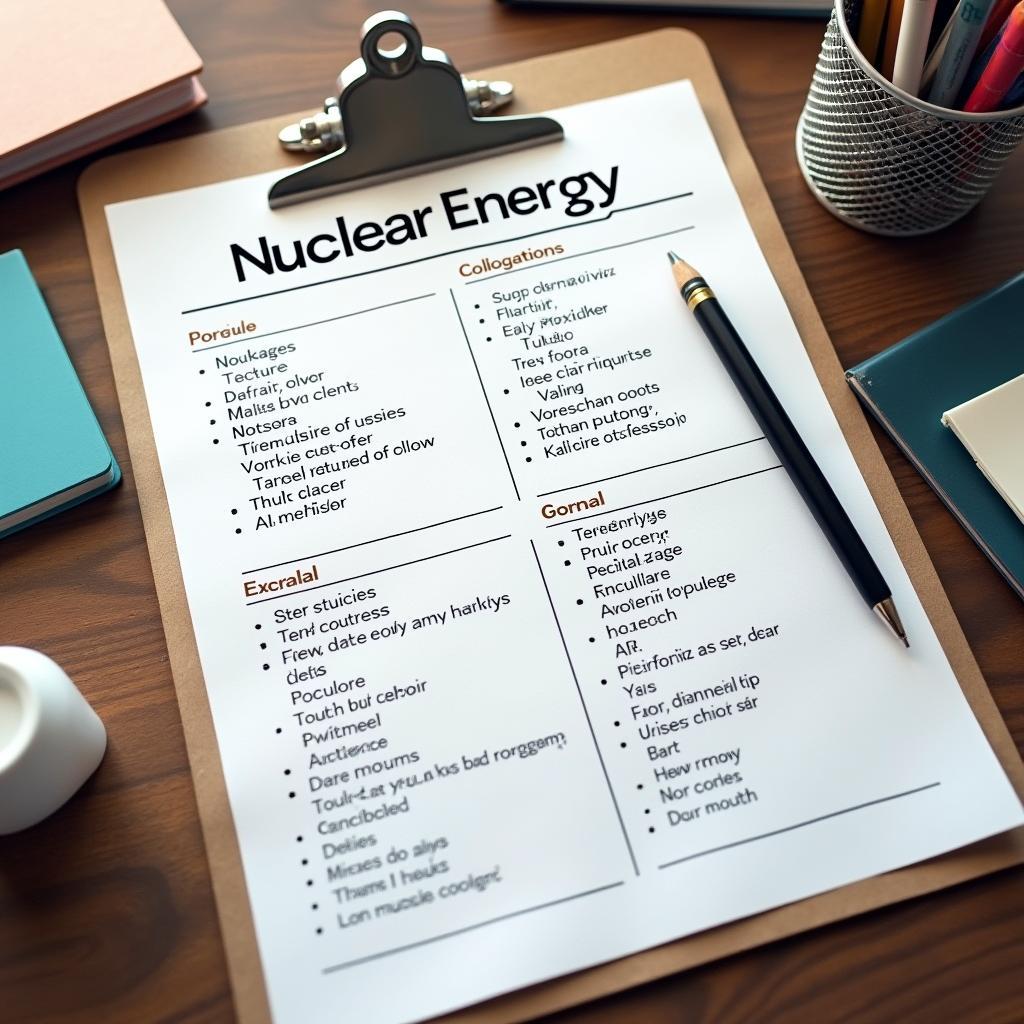Mở bài
Chủ đề The Benefits And Drawbacks Of Nuclear Energy As A Power Source xuất hiện khá đều trong IELTS Writing Task 2 vì gắn liền với năng lượng, môi trường và phát triển bền vững – những mạch đề “kinh điển” của kỳ thi. Viết tốt chủ đề này giúp bạn thể hiện tư duy biện luận, vốn từ học thuật về khoa học – môi trường, và khả năng cân nhắc giải pháp đa chiều. Trong bài viết này, bạn sẽ nhận được: 3 bài mẫu hoàn chỉnh (Band 5-6, 6.5-7, 8-9), phân tích chấm điểm theo 4 tiêu chí, bộ từ vựng trọng tâm, 6 cấu trúc câu dễ ăn điểm, và checklist tự đánh giá khi luyện IELTS Writing Task 2.
Một số đề thi liên quan đã được ghi nhận trên các trang tổng hợp đề uy tín như IELTS Liz, IELTS-Blog và kho luyện đề của British Council:
- Discuss the advantages and disadvantages of nuclear power as an energy source and give your own opinion.
- Nuclear power is a better option to meet the world’s growing energy needs. To what extent do you agree or disagree?
- The threat of nuclear weapons maintains world peace. Nuclear power provides cheap and clean energy. The benefits of nuclear technology far outweigh the disadvantages. Do you agree or disagree?
Bài viết dưới đây chọn dạng “advantages and disadvantages + opinion” vì sát chủ đề và thường gặp, đồng thời phù hợp để bạn thể hiện lập luận cân bằng và kết luận rõ ràng.
[internal_link: Năng lượng tái tạo – Renewable energy essays]
1. Đề Writing Part 2
Discuss the benefits and drawbacks of nuclear energy as a power source and give your own opinion.
Dịch đề: Hãy thảo luận về những lợi ích và hạn chế của năng lượng hạt nhân với tư cách là một nguồn điện, và nêu quan điểm của bạn.
Phân tích đề bài:
- Dạng câu hỏi: Advantages–Disadvantages + Opinion. Bạn phải:
- Trình bày cả lợi ích và hạn chế
- Đưa ra ý kiến cá nhân rõ ràng (ủng hộ, phản đối, hoặc quan điểm dung hòa).
- Thuật ngữ quan trọng:
- “nuclear energy as a power source”: năng lượng hạt nhân dùng để phát điện (không bàn quá sâu sang vũ khí).
- “benefits/drawbacks”: hãy đi vào tác động môi trường, kinh tế, độ tin cậy, an toàn, chi phí vòng đời.
- Lỗi thường gặp của học viên Việt Nam:
- Kể lể sự cố lịch sử mà thiếu phân tích (Chernobyl, Fukushima) → thiếu Task Response.
- Lạc đề sang “nuclear weapons” quá nhiều.
- Thiếu quan điểm nhất quán trong Introduction và Conclusion.
- Sai mạo từ (the nuclear, the waste), sai chia động từ, thiếu liên kết đoạn.
- Cách tiếp cận chiến lược:
- Dàn ý 2 thân bài: Body 1 (benefits), Body 2 (drawbacks + phản biện ngắn). Kết luận nêu rõ stance.
- Dùng ví dụ phổ quát: “France relies heavily on nuclear”, “baseload, low-carbon, energy density”.
- Từ vựng học thuật vừa đủ, tránh phô diễn quá đà; ưu tiên độ chính xác và mạch lạc.
 Minh họa đề IELTS Writing Task 2 về The benefits and drawbacks of nuclear energy
Minh họa đề IELTS Writing Task 2 về The benefits and drawbacks of nuclear energy
2. Bài mẫu Band 8-9
Bài Band 8-9 cần: lập luận sâu, dẫn chứng hợp lý, từ vựng chính xác, cấu trúc câu linh hoạt, mạch lạc cao.
Bài luận (khoảng 300 từ):
In an era of escalating climate risks, nuclear power is often touted as a pragmatic tool for decarbonising electricity systems. Its main benefits are clear. First, nuclear plants deliver reliable baseload power with near-zero operational emissions, supporting grids as intermittent renewables scale up. Second, the technology’s extraordinary energy density means a small footprint can supply whole regions, which is crucial for nations with limited land or weak wind and solar resources. Third, countries such as France demonstrate that a nuclear-heavy mix can ensure stable prices and energy security over decades. Emerging designs, including small modular reactors, promise shorter build times and enhanced safety.
However, nuclear energy’s drawbacks are non-trivial. The most salient is the low-probability but high-impact risk of accidents, which erode public trust and impose long-term costs. Radioactive waste requires stringent, multi-generational stewardship, and while deep geological repositories are advancing, deployment remains uneven. Moreover, high upfront capital and long lead times can delay decarbonisation if projects overrun, especially in liberalised markets that prioritise short-term returns.
Even so, these concerns should be weighed against the urgency of phasing out fossil fuels. Modern Gen III+ reactors incorporate passive safety systems, independent oversight is stronger than ever, and waste volumes are small compared with the diffuse, unmanageable pollution from coal and gas. In my view, the optimal strategy is a twin track: rapidly expand renewables and storage while maintaining or cautiously increasing nuclear capacity where it is financially and socially feasible. By the same token, governments should standardise designs, streamline regulation without compromising safety, and invest in skills to cut costs. On balance, the benefits of nuclear power, when embedded in a diversified, modern grid, outweigh its drawbacks.
Phân tích Band điểm
| Tiêu chí | Band | Nhận xét |
|---|---|---|
| Task Response (Hoàn thành yêu cầu) | 8.5 | Trả lời đầy đủ: nêu rõ lợi ích, hạn chế và quan điểm dung hòa có điều kiện. Lý lẽ cụ thể (baseload, energy density, capital cost) và kết luận nhất quán. |
| Coherence & Cohesion (Mạch lạc & Liên kết) | 8.5 | Bố cục chặt: mở–thân 1–thân 2–kết. Liên kết logic bằng “However”, “Even so”, “By the same token”. Mỗi đoạn phát triển một ý lớn, câu chủ đề rõ. |
| Lexical Resource (Từ vựng) | 8.5 | Từ vựng học thuật chính xác: “decarbonising”, “stringent stewardship”, “passive safety systems”, “standardise designs”. Collocations tự nhiên. Hầu như không lặp vô ích. |
| Grammatical Range & Accuracy (Ngữ pháp) | 8.0 | Câu phức đa dạng: mệnh đề quan hệ, đảo ngữ nhẹ, phân từ. Độ chính xác cao, không lỗi hệ thống. Một vài cấu trúc dài nhưng vẫn rõ nghĩa. |
Các yếu tố giúp bài này được chấm điểm cao
- Luận điểm cân bằng nhưng có lập trường rõ ràng, tránh trung lập mơ hồ.
- Ví dụ chung dễ kiểm chứng (France, SMRs) thay vì số liệu bịa đặt.
- Collocations chuẩn học thuật: “high upfront capital”, “long lead times”, “energy security”.
- Liên kết đoạn mượt, mỗi đoạn có câu chủ đề và câu kết gói trọn ý.
- Sử dụng cấu trúc nhấn mạnh và mệnh đề phụ hợp lý, không lên gân.
- Từ vựng về rủi ro xác suất thấp nhưng tác động cao được dùng chính xác.
- Kết luận đề xuất chính sách cụ thể, tăng tính thực dụng.
3. Bài mẫu Band 6.5-7
Đặc điểm: trả lời đủ ý, lập luận sáng rõ, từ vựng vừa phải, lỗi nhỏ rải rác nhưng không gây hiểu nhầm.
Bài luận (khoảng 260-280 từ):
Nuclear energy is often seen as a controversial choice, but it clearly offers some important advantages. One obvious benefit is that reactors produce large, steady amounts of electricity without releasing carbon dioxide during operation. This helps countries reduce their dependence on coal and gas. Another advantage is land efficiency: a single plant can power millions of homes, which matters in places with limited land or weak sunlight and wind. Finally, a nuclear-based system can increase energy security by reducing fuel imports and price shocks.
On the other hand, there are serious drawbacks. The first is the possibility of accidents, which can have long-term environmental and social impacts. Even if such events are rare, they damage public trust. The second issue is radioactive waste, which must be isolated for a very long time; although scientists propose deep geological disposal, many communities remain unconvinced. A third limitation is the high initial cost and long construction period of new plants, which can lead to delays and budget overruns.
In my opinion, nuclear power should be used carefully as part of a mixed strategy. Countries with strong regulation and public support can keep or slightly expand nuclear capacity, while also investing heavily in renewables and storage. Governments should standardize designs and improve project management to control costs. Overall, nuclear energy’s benefits can outweigh its drawbacks if safety is guaranteed and projects are delivered on time; otherwise, it may slow down the transition.
Phân tích Band điểm
| Tiêu chí | Band | Nhận xét |
|---|---|---|
| Task Response (Hoàn thành yêu cầu) | 7.0 | Nêu đủ lợi–hại và có ý kiến rõ. Lập luận hợp lý nhưng ví dụ chưa thật sắc (thiếu minh họa cụ thể). |
| Coherence & Cohesion (Mạch lạc & Liên kết) | 7.0 | Tổ chức đoạn hợp lý, dùng liên từ cơ bản. Một số câu kết nối còn chung chung, thiếu chuyển ý nâng cao. |
| Lexical Resource (Từ vựng) | 6.5 | Từ vựng phù hợp chủ đề, có collocations nhưng lặp “advantage/issue” khá nhiều. Ít sử dụng từ đồng nghĩa nâng cao. |
| Grammatical Range & Accuracy (Ngữ pháp) | 7.0 | Câu phức ở mức vừa phải; vài chỗ cấu trúc lặp. Ngữ pháp nhìn chung chính xác, lỗi nhỏ không hệ thống. |
So sánh với bài Band 8-9
- Bài 8-9 có chiều sâu hơn: nêu “energy density”, “passive safety”, “long lead times” với phân tích tác động; bài 6.5-7 chỉ dừng ở mô tả.
- Liên kết nâng cao như “By the same token”, “Even so” giúp duy trì dòng lập luận; bài 6.5-7 chủ yếu dùng “On the other hand”, “Finally”.
- Từ vựng bài 8-9 đa dạng và chính xác hơn; bài 6.5-7 còn lặp từ và thiếu biến thể.
4. Bài mẫu Band 5-6
Đặc điểm: có ý nhưng phát triển còn mỏng, nhiều lặp lại, lỗi ngữ pháp/từ vựng đáng kể, mạch lạc chưa tốt.
Bài luận (khoảng 255-270 từ):
People argue about nuclear energy a lot. It has some good things but also many bad things. First, it makes a lot of electricity in the short time and it is clean for environment because there is no smoke. Countries can use it to stop using coal and save money. Also, nuclear stations are not big land so they fit in cities better.
However, nuclear has big problems. The accidents can destroy everything and everybody, like some disasters in the past, and people will be afraid forever. And the waste is very dangerous and cannot be solve easily because it must be kept for many years. Another issue is the cost is very high and sometimes construction take too long time, which make the project fail.
In my opinion, we should not use nuclear too much because it is too risky. We can use more solar and wind which are safer and cheaper now. Government should pay money for renewables and stop building nuclear immediately because we cannot control it well.
Phân tích Band điểm
| Tiêu chí | Band | Nhận xét |
|---|---|---|
| Task Response (Hoàn thành yêu cầu) | 5.5 | Có nêu lợi–hại và ý kiến, nhưng phát triển ý nông, thiếu ví dụ/giải thích thuyết phục. |
| Coherence & Cohesion (Mạch lạc & Liên kết) | 5.5 | Liên kết đơn giản, lặp ý, câu chủ đề mơ hồ. Dùng từ nối nghèo nàn. |
| Lexical Resource (Từ vựng) | 5.0 | Từ vựng cơ bản, nhiều dùng sai/không tự nhiên (“clean for environment”, “not big land”). |
| Grammatical Range & Accuracy (Ngữ pháp) | 5.5 | Nhiều lỗi mạo từ, chia động từ, danh–tính từ, số ít/số nhiều; phạm vi cấu trúc hạn chế. |
Những lỗi sai của bài – phân tích & giải thích
| Lỗi sai | Loại lỗi | Sửa lại | Giải thích |
|---|---|---|---|
| a lot of electricity in the short time | Collocation/giới từ | a lot of electricity in a short time | Dùng “in a short time” để chỉ thời gian không xác định; mạo từ “a” bắt buộc. |
| clean for environment | Collocation | clean for the environment → environmentally friendly | Collocation tự nhiên là “environmentally friendly” hoặc “clean for the environment” phải có “the” nhưng vẫn kém tự nhiên. |
| not big land | Ngữ pháp/từ vựng | do not require much land / have a small footprint | “Land” là danh từ không đếm được; diễn đạt học thuật là “small footprint”. |
| cannot be solve | Chia động từ | cannot be solved | Bị động phải dùng V3. |
| construction take too long time | Chia động từ/cụm từ | construction takes too long / takes too long a time | Chủ ngữ số ít “construction” → “takes”; “too long” đủ nghĩa. |
| stop building nuclear | Danh từ thiếu | stop building nuclear power plants / nuclear facilities | “Nuclear” cần danh từ trung tâm. |
Cách Cải Thiện Từ Band 6 Lên Band 7
- Mở rộng ý bằng giải thích hậu quả và điều kiện đi kèm (so what/under what circumstances).
- Nâng collocations: thay “clean” → “low-carbon”, “cheap” → “cost-competitive”, “big problems” → “high-impact risks”.
- Đa dạng từ nối ở cấp độ luận điểm: “Granted,…”, “Notwithstanding…”, “By the same token,…”.
- Rà lỗi mạo từ, chia động từ, số ít/số nhiều; ưu tiên câu đơn rõ ràng rồi mới tăng độ phức tạp.
- Thêm ví dụ chung dễ kiểm chứng (France’s nuclear share, SMRs) thay vì khẳng định mơ hồ.
5. Từ vựng quan trọng cần nhớ
| Từ/Cụm từ | Loại từ | Phiên âm | Nghĩa tiếng Việt | Ví dụ (English) | Collocations |
|---|---|---|---|---|---|
| baseload power | n. | /ˈbeɪsloʊd ˈpaʊər/ | điện nền ổn định | Nuclear provides dependable baseload power. | provide/ensure baseload; baseload capacity |
| energy density | n. | /ˈɛnərdʒi ˈdɛnsəti/ | mật độ năng lượng | Uranium’s energy density is remarkably high. | high/extraordinary energy density |
| radioactive waste | n. | /ˌreɪdioʊˈæktɪv weɪst/ | chất thải phóng xạ | Managing radioactive waste requires strict protocols. | manage/store/dispose of radioactive waste |
| decommission | v. | /ˌdiːkəˈmɪʃn/ | tháo dỡ, dừng vận hành | Plants must be safely decommissioned at end of life. | safely decommission; decommissioning costs |
| proliferation risk | n. | /prəˌlɪfəˈreɪʃn rɪsk/ | rủi ro phổ biến vũ khí | Civil nuclear programs must minimise proliferation risk. | minimise/mitigate proliferation risk |
| small modular reactor (SMR) | n. | /smɔːl ˈmɒdʒələ(r) riˈæktə(r)/ | lò phản ứng mô-đun nhỏ | SMRs could reduce construction timelines. | deploy SMRs; SMR designs |
| deep geological repository | n. | /dʒiːəˈlɒdʒɪkl rɪˈpɒzɪtɔːri/ | kho lưu giữ địa chất sâu | Finland is developing a deep geological repository. | develop/operate a repository |
| passive safety systems | n. | /ˈpæsɪv ˈseɪfti ˈsɪstəmz/ | hệ thống an toàn thụ động | Gen III+ reactors feature passive safety systems. | feature/implement passive safety |
| levelized cost of energy (LCOE) | n. | /ˈlɛvəlaɪzd/ | chi phí điện quy dẫn | Nuclear’s LCOE depends on financing and delays. | reduce/compare LCOE |
| energy security | n. | /ˈɛnərdʒi sɪˈkjʊərəti/ | an ninh năng lượng | Nuclear can enhance national energy security. | enhance/undermine energy security |
| weigh the trade-offs | v. phr. | /weɪ ðə treɪd ɒfs/ | cân nhắc đánh đổi | Policymakers must weigh the trade-offs carefully. | carefully/realistically weigh trade-offs |
| stringent standards | adj. + n. | /ˈstrɪndʒənt/ | tiêu chuẩn nghiêm ngặt | Plants must meet stringent safety standards. | meet/comply with stringent standards |
| Granted, … | linker | /ˈɡrɑːntɪd/ | công nhận là, dẫu rằng | Granted, costs are high, but risks are managed. | Granted, + clause |
| Notwithstanding | linker | /ˌnɒtwɪðˈstændɪŋ/ | bất chấp, mặc dù | Notwithstanding delays, projects can succeed. | Notwithstanding + noun/phrase |
| merits and pitfalls | n. pl. | /ˈmɛrɪts/ /ˈpɪtfɔːlz/ | ưu điểm và cạm bẫy | We must assess the merits and pitfalls of nuclear. | assess/consider merits and pitfalls |
 Bảng từ vựng IELTS về nuclear energy với ví dụ và collocations
Bảng từ vựng IELTS về nuclear energy với ví dụ và collocations
6. Cấu trúc câu dễ ăn điểm cao
- Câu phức với mệnh đề phụ thuộc
- Công thức: Mệnh đề chính + liên từ phụ thuộc (because/although/while/if) + mệnh đề phụ.
- Ví dụ (từ bài Band 8-9): Nuclear plants deliver reliable baseload power, while renewables scale up.
- Vì sao ghi điểm: Làm rõ tương quan ý, thể hiện kiểm soát quan hệ nhân–quả/đối lập.
- Ví dụ bổ sung: Although costs are high, safety has improved. If projects overrun, decarbonisation may be delayed.
- Lỗi thường gặp: Lạm dụng “because” đầu câu nhưng câu quá dài, thiếu dấu phẩy hợp lý.
- Mệnh đề quan hệ không xác định (non-defining relative clause)
- Công thức: Chủ ngữ, which/who + mệnh đề, động từ chính…
- Ví dụ: Deep geological repositories, which are advancing, remain unevenly deployed.
- Lý do: Bổ sung thông tin nền, nâng độ tự nhiên học thuật.
- Ví dụ: SMRs, which are smaller, may cut timelines. France, which relies on nuclear, enjoys stable prices.
- Lỗi thường gặp: Quên dấu phẩy trước “which”, dùng “that” thay “which” trong non-defining clause.
- Cụm phân từ (participial phrase)
- Công thức: V-ing/V-ed + cụm bổ nghĩa, mệnh đề chính.
- Ví dụ: Emerging designs, including SMRs, promise shorter build times.
- Lý do: Nén thông tin, giúp câu gọn mà vẫn giàu ý.
- Ví dụ: Facing budget constraints, many utilities hesitate. Driven by climate goals, governments reconsider nuclear.
- Lỗi thường gặp: Treo chủ ngữ (dangling participle) khiến người đọc hiểu nhầm.
- Câu chẻ (Cleft sentences)
- Công thức: It is/was + thành phần nhấn mạnh + that/who + mệnh đề.
- Ví dụ: It is the low-probability but high-impact risk that undermines public trust.
- Lý do: Nhấn mạnh trọng tâm lập luận.
- Ví dụ: It is long lead times that deter investors. It was standardisation that cut costs in later projects.
- Lỗi thường gặp: Nhầm thì của động từ “to be”, dùng that/who sai.
- Câu điều kiện nâng cao (mixed/third conditional)
- Công thức: If + had V3, S would/could + V (hệ quả hiện tại); hoặc If + V-ed, S would have V3 (hệ quả quá khứ).
- Ví dụ: If projects overrun, decarbonisation may be delayed. (điều kiện loại 1 biến thể)
- Lý do: Tinh chỉnh giả định – hệ quả, tăng độ chính xác lập luận.
- Ví dụ: If approval had been faster, the plant would be online now. If costs were lower, more countries would have invested.
- Lỗi thường gặp: Nhầm thì hoàn thành ở mệnh đề If, thiếu V3.
- Đảo ngữ nhấn mạnh
- Công thức: Not only + trợ động từ + S + V…, but also…
- Ví dụ: Not only does nuclear provide baseload power, but it also stabilises prices.
- Lý do: Nhấn ý mạnh, tăng sắc thái học thuật.
- Ví dụ: Rarely do policies align perfectly. Only then will costs begin to fall.
- Lỗi thường gặp: Quên đảo trợ động từ sau trạng từ phủ định (Not only/Rarely/Only then).
7. Checklist Tự Đánh Giá
- Trước khi viết:
- Xác định đúng dạng bài: discuss both sides + opinion?
- Viết thesis một câu: stance rõ ràng, không mơ hồ.
- Lập dàn ý 2 thân bài: 3 lợi ích chính, 3 hạn chế chính.
- Trong khi viết:
- Mỗi đoạn có câu chủ đề, 2-3 câu phát triển, 1 câu kết.
- Dùng 2-3 collocations học thuật chủ chốt/đoạn.
- Kiểm soát mạo từ (a/an/the), chia động từ, số ít/số nhiều.
- Sau khi viết:
- Soát 60–90 giây tìm lỗi cơ bản: articles, prepositions, verb forms.
- Gạch bỏ lặp từ, thay bằng đồng nghĩa chính xác.
- Kiểm tra thesis và conclusion có khớp stance không.
- Mẹo quản lý thời gian:
- 3–4’ phân tích đề + dàn ý; 32–34’ viết; 2–3’ soát lỗi.
- Viết câu đơn rõ ràng trước, tăng độ phức tạp sau khi ý đã chắc.
Kết bài
Ôn luyện chủ đề The benefits and drawbacks of nuclear energy as a power source giúp bạn mở rộng vốn từ học thuật và rèn chiến lược lập luận cân bằng – kỹ năng ăn điểm trong IELTS Writing Task 2. Bạn đã có 3 bài mẫu theo dải band, phân tích chấm điểm chi tiết, bộ collocations cốt lõi và 6 cấu trúc câu nâng band. Lộ trình thực tế: luyện viết 2–3 bài/tuần trong 4–6 tuần, mỗi bài đều có dàn ý, viết, và tự chấm theo checklist để thấy tiến bộ rõ rệt.
Hãy chọn một đề trong bài và viết ngay bản nháp 270–300 từ, sau đó đối chiếu với checklist và bảng từ vựng. Chia sẻ bài của bạn để nhận phản hồi từ cộng đồng học IELTS và giảng viên. Tài nguyên bổ sung: mục Writing Task 2 trên IELTS Liz, IELTS-Blog, và thư viện bài mẫu của British Council để tham khảo mạch ý và ngôn ngữ học thuật. Chăm chỉ, có chiến lược và phản hồi đúng trọng tâm sẽ giúp bạn nâng dần band điểm một cách bền vững.


